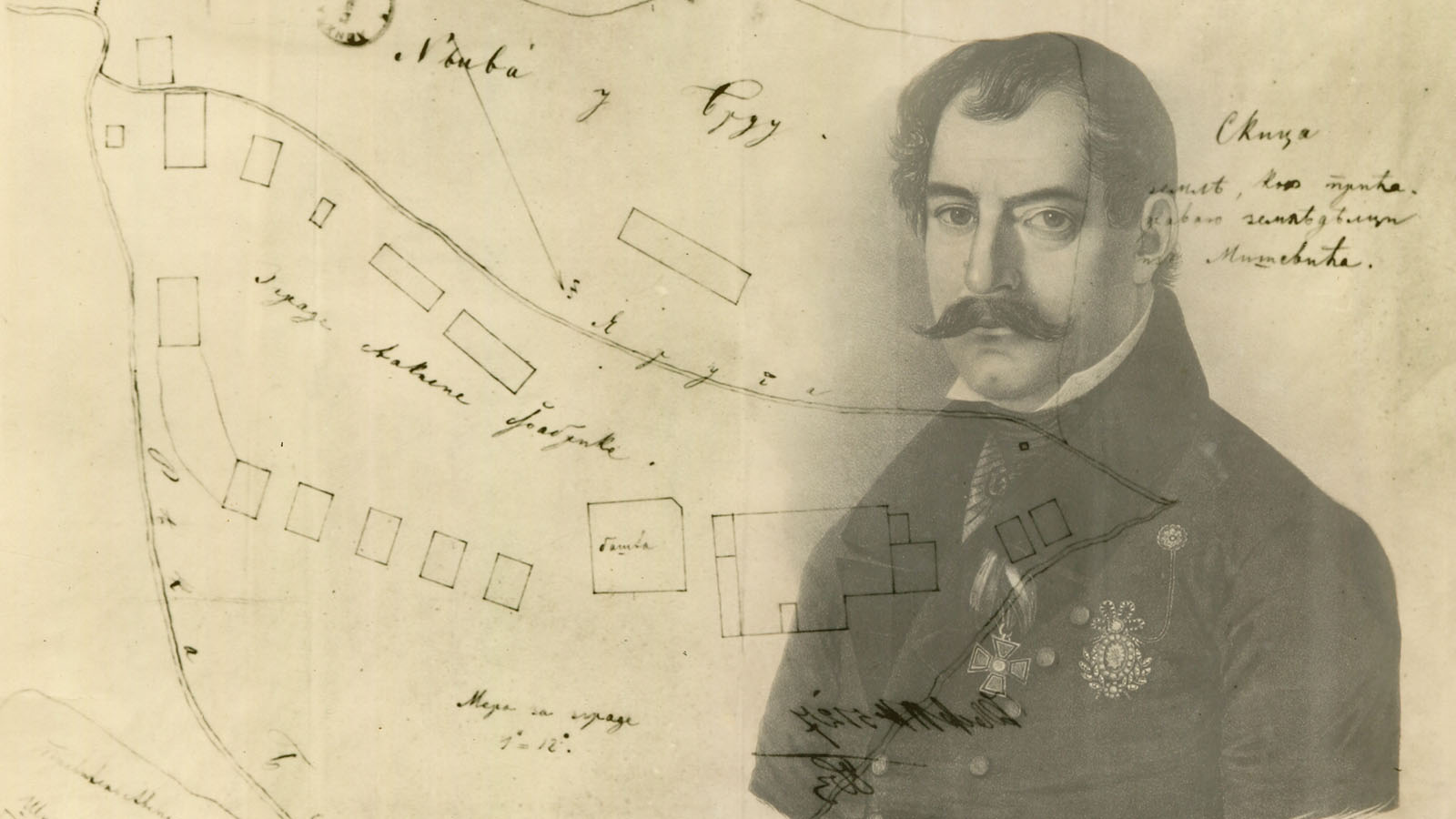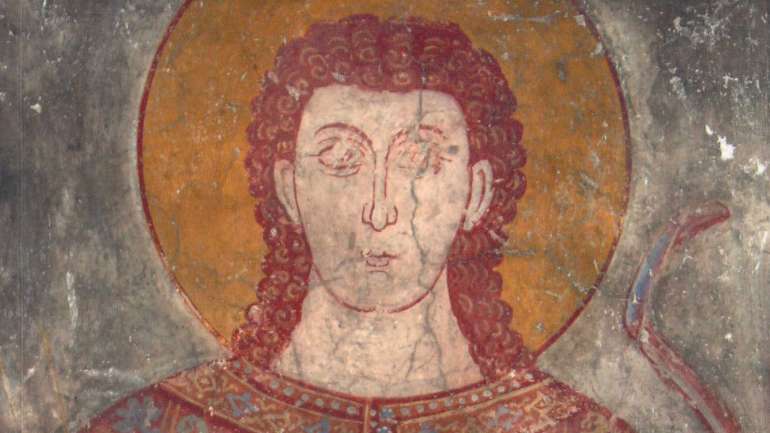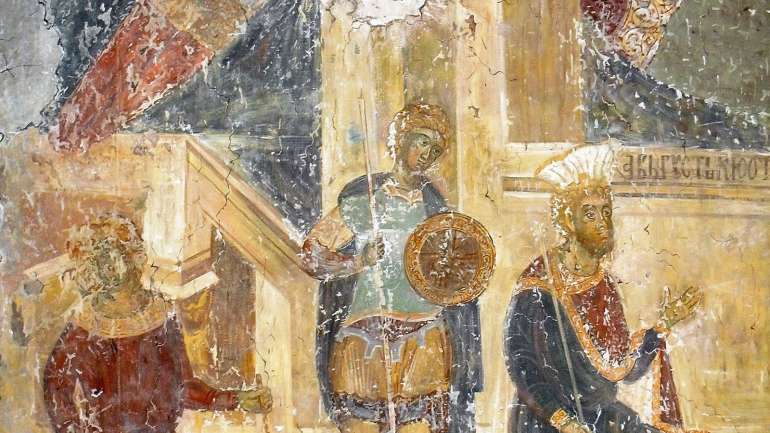By: Jasmina Trajkov, museum advisor
The first industrial production in Serbia was started near Jagodina in 1846 with the establishment of the Avram Petronijević glass factory on the location between the villages of Mišević and Belica. The factory operated well for some time, but could not withstand the competition represented by the import of glass products from Austria. The sudden death of Petronijević in 1852 meant the end of the first Serbian glass factory.
Avram Petronijević (Tekija, 1791– onstantinople, 1852) was a prominent figure of the time, secretary of the prince’s office, ombudsman, minister of foreign affairs and a member of the State Council. He finished primary and commercial school in Orșova (Romania). He moved to Serbia in 1817, taking with him his parents who settled in Jagodina. Avram’s wife and children also lived in the city until 1842, when they moved to Belgrade. His house was located on the road to Kragujevac, near the Old Church, on the site of today’s hospital complex, and was built in 1833. Petronijević moved into it the following year, in 1834. After Petronijević’s death, it was leased to the Head of the Jagodina District, and during the second half of the 19th century, the District Hospital was located here.
After gaining autonomy in 1830, the development and modernization of life in Serbia began. Glass was increasingly in use. It was used in the making of windows on town houses instead of paper, and glass household was increasingly in use. Although it was rich in raw materials for glass production, Serbia imported glass products. Before the founding of the glassworks in Jagodina, Nikola Stanojević and Pavel Adamović tried to start domestic glass production in 1832, but their requests remained unanswered.
Avram Petronijević decided to build a glass factory in Jagodina at the end of 1839 and wrote to the State Council to approve it. He did not wait for an answer because in the spring of 1840 he had to leave Serbia due to political circumstances. He again applied for the opening of the factory to the State Council in the spring of 1843. In it, he demanded, among other things, “the exclusive right to 14 years that no one else can raise a glassblower in the country”, free felling and use of firewood and ash on Crni Vrh, as well as exploitation of the necessary stone for masonry and glass production.
On March 31, 1843, Prince Aleksandar Karađorđević agreed with the decision of the Council, and Petronijević received a concession for the production of glass and the exploitation of raw materials for 12 years. The unfavorable political situation and strained relations with Prince Aleksandar Karađorđević were the reason why the glassworks did not work. Avram Petronijević was expelled from Serbia, and returned from emigration in September 1844. Two years later, he again appealed to the prince in which he reminded him of the decision from 1843 and asked for confirmation of his permission to build a glassworks. Petronijević received approval and privileges for opening a factory and exploiting raw materials without compensation in March 1846. He built buildings for the needs of the factory, as well as apartments for workers, on the leased and partially purchased land, which was located between the river Belica and the villages of Mišević and Belica, which will later be named “Avramovac”. This place was convenient because there was enough white rock nearby, good running water and a lot of forest. The factory worked according to the German-Czech system, according to which the making of glass was based on melting a mixture of potash and sand with the addition of lime. The equipment was procured in Bavaria, and the masters were brought from Bavaria and the Czech Republic, so the technology of making glass was similar to that used in Czech and Bavarian manufactories. Until 1849, the manager of the glassworks was a merchant from Zemun Konstantin Tomić, and later he was most likely succeeded by his brother Teodor. According to the technical arrangement and method of production based on manual labor and water drive, the manufactory of Avram Petronijević was outdated, but as the first of its kind in Serbia, it met the needs of the urban and rural population at the time. The manufactory had two furnaces for melting glass with nine pots each and a mill that was used to grind glass. In addition to flat glass for windows, goblets, bottles (for wine and polishes), glasses (for wine and brandy), flasks, bowls and trays, as well as candlesticks were produced. The objects were created by blowing and free shaping, blowing into a mold, and perhaps pressing. Additional decoration was brushed or painted.
The first glass in the factory of Avram Petronijević was produced on the day of St. Clement, November 25, according to the old calendar, ie December 8, according to the new calendar, 1846. On that day, Prince Aleksandar Karađorđević has a celebration in Topola, in the presence of numerous distinguished guests. As the first product of the glassworks, “several large glasses” were sent to the prince in Topola, from which the guests toasted during the celebration.
In the summer of 1846, just a few months after its founding, an epidemic of typhoid fever broke out in the glass factory, which spread rapidly because there were no doctors in the district. The disease was brought by the Germans who came to work in the factory, and the epidemic affected not only the factory workers but also the inhabitants of the surrounding villages. Avram Petronijević invited Dr. Josif Pančić, who was waiting in Belgrade at that time for admission to the service, to accept the position of factory doctor in Belica. Pančić accepted these duties on January 31, 1947 and successfully stopped the epidemic. Due to the success in treatment and the attitude towards patients, the population of Jagodina demanded that Pančić be appointed district doctor, which was his wish as well. In February 1847, the Guardianship of Internal Affairs appointed Pančić “a contract city doctor of the second class and a temporary physician of the Jagodina District”.
The factory had income but it lacked working capital to start new investments and modernize production. Large imports of glass from Austria represented a serious competition. The factory operated until the sudden death of Petronijević, which befell him in 1852 during a diplomatic mission in Constantinople.
After his death, Petronijević’s family found themselves in a difficult financial situation, so they turned to the state for help. Despite the commitment of Avram’s heirs to continue the work of the factory, it was bought from Avram’s son Ljubomir in the name of settling debts to the state. Long after the closure of Avram’s glassworks, not a single glass factory started operating on the territory of Serbia, while the import of glass goods was constantly increasing.





